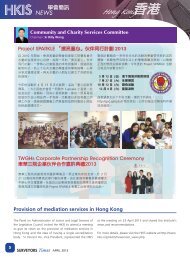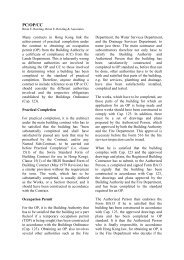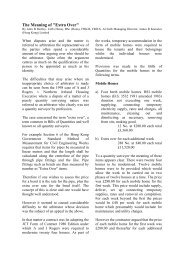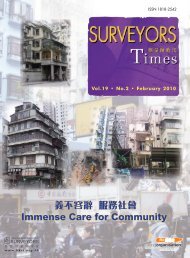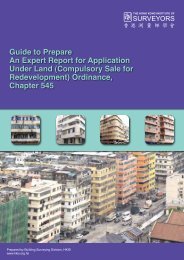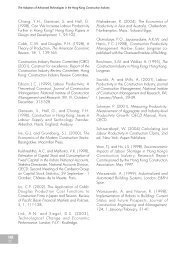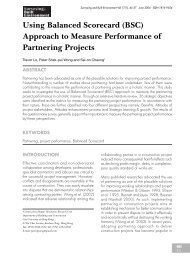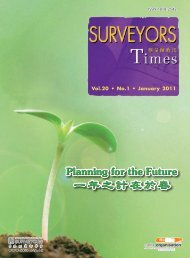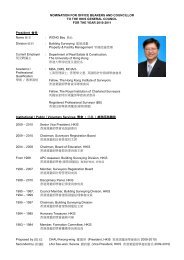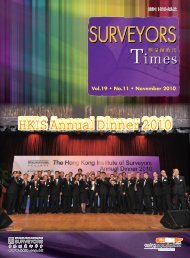Surveying & Built Environment Vol. 22 Issue 1 (December 2012)
Surveying & Built Environment Vol. 22 Issue 1 (December 2012)
Surveying & Built Environment Vol. 22 Issue 1 (December 2012)
Create successful ePaper yourself
Turn your PDF publications into a flip-book with our unique Google optimized e-Paper software.
SBE<br />
38<br />
Good Property Valuation in Emerging Real Estate Markets? Evidence from Ghana<br />
INTRoduCTIoN<br />
The size of the housing sector in<br />
Ghana, one of Africa’s most urbanised<br />
countries, is growing. In 1970, the<br />
housing sector was made up of only<br />
941,639 houses. Now, with increased<br />
population and demand, there are over<br />
2,000,000 houses in Ghana (Ghana<br />
Statistical Service, 1970; 2005).<br />
Similarly, the quality of the houses has<br />
improved over time. In 1874, Accra,<br />
the capital city, was perceived as a<br />
city made up of thatched houses and<br />
crooked streets (Grant and Yankson,<br />
2003, p.66), today that city has gated<br />
communities with villas (Grant, 2009).<br />
The changing nature of the housing<br />
sector warrants a reflection on how<br />
Ghanaian professionals assess property<br />
values. The literature on real estate<br />
markets in sub-Saharan Africa, where<br />
Ghana is located, has largely ignored<br />
property valuation (see, for example,<br />
Ebohon et al., 2002). A small number<br />
of studies have examined valuation<br />
practices (e.g., Amidu and Aluko, 2007;<br />
Aluko, 2007; Babawale and Ajayi,<br />
2011; Otegbulu and Babawale, 2011).<br />
However, most of them focus on factors<br />
that influence the opinion of valuers.<br />
Also, almost all of them are about the<br />
situation in Nigeria. To date, research<br />
on valuation methods in other countries<br />
in sub-Saharan Africa remains thin.<br />
So, analysing valuation in Ghana is<br />
important for expanding the knowledge<br />
base of valuation methods in sub-<br />
Saharan Africa.<br />
Valuation in Ghana is influenced by<br />
the United Kingdom, which colonised<br />
the country from July 1874 to March<br />
1957 (Ministry of Education, 1991,<br />
p.99). During that period there were<br />
some surveyors, who were deemed<br />
‘licensed’ by virtue of consistently<br />
working according to the standards<br />
laid down in legislation such as the<br />
Gold Coast Technical Instructions of<br />
1921 (Ofori-Boadi, 2006). According<br />
to Emmanuel Mohenu, Director of<br />
<strong>Surveying</strong> and Mapping Division of<br />
the Lands Commission of Ghana (now<br />
called the New Lands Commission),<br />
surveying in Ghana started about 100<br />
years ago when Brigadier-General<br />
Sir Frederick Gordon Guggisberg,<br />
K.C.M.G., D.S.O., R.E. (1869-1930) 1<br />
was the Governor of the Gold Coast (as<br />
Ghana was then called) (Zaney, 2009).<br />
Although there were surveyors with<br />
various specialisations, the dominant<br />
group was the land surveyors (LISAG,<br />
2011). On 28th February 1969, over<br />
a decade after independence (which<br />
was obtained on 6th of March, 1957),<br />
the Ghana Institution of Surveyors, the<br />
professional body that tries to regulate<br />
professional valuation in Ghana, was<br />
established (Ghana Institution of<br />
Surveyors, 2011).<br />
There are already some studies of<br />
valuation in Ghana that seek to describe<br />
the role of valuers (see, for example,<br />
Mends, 2006 and Ayittey et al., 2006)<br />
and how they are trained (Obeng-<br />
Odoom and Ameyaw, 2010; Obeng-<br />
Odoom and Ameyaw, 2011), so this<br />
paper extends that literature. It examines<br />
valuation methods, identifies their<br />
peculiarities in the context where they<br />
are used and highlights how valuers<br />
adapt the methods to the prevailing<br />
1 Editor’s note: Guggisberg was Governor from 1919 to 1928. More importantly, He was himself an<br />
army surveyor and had been Director of Surveys of the Gold Coast 1905 to 1908. From 1910 to 1914, he<br />
was in the same post in Nigeria. In 1911 he wrote The Handbook of the Southern Nigeria Survey.



